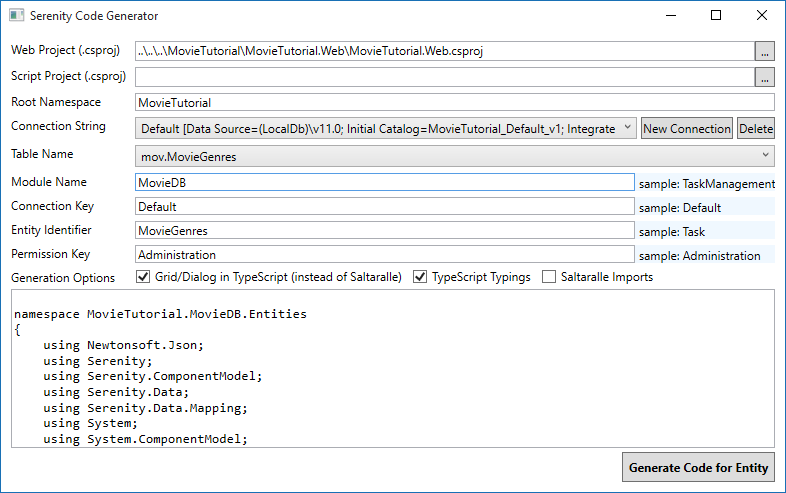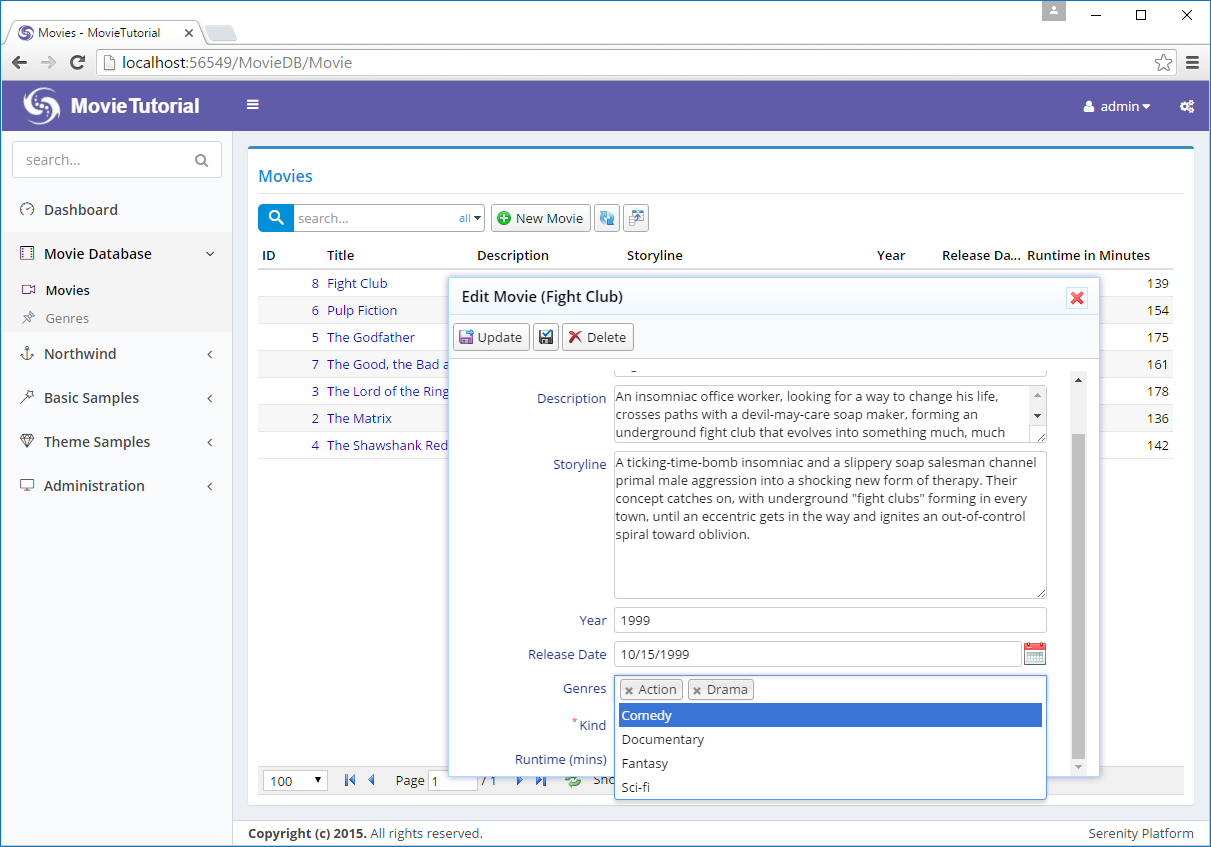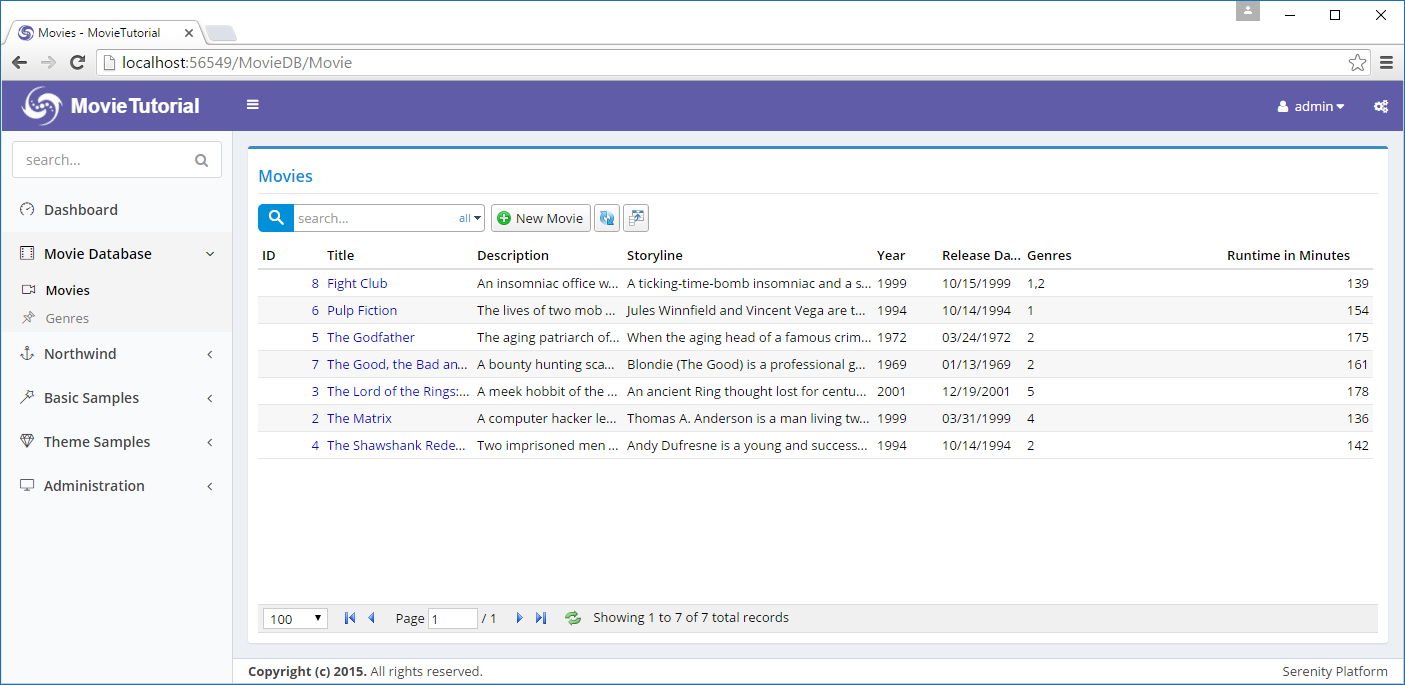Allowing Multiple Genre Selection
It happens. Requirements change. Now we want to allow selecting multiple genres for a movie.
For this, we need a M-N mapping table that will let us link any movie to multiple genres.
Creating MovieGenres Table
As usual, we start with a migration:
Modules/Common/Migrations/DefaultDB/ DefaultDB_20160528_115400_MovieGenres.cs:
using FluentMigrator;
namespace MovieTutorial.Migrations.DefaultDB
{
[Migration(20160528115400)]
public class DefaultDB_20160528_115400_MovieGenres : Migration
{
public override void Up()
{
Create.Table("MovieGenres").InSchema("mov")
.WithColumn("MovieGenreId").AsInt32()
.Identity().PrimaryKey().NotNullable()
.WithColumn("MovieId").AsInt32().NotNullable()
.ForeignKey("FK_MovieGenres_MovieId",
"mov", "Movie", "MovieId")
.WithColumn("GenreId").AsInt32().NotNullable()
.ForeignKey("FK_MovieGenres_GenreId",
"mov", "Genre", "GenreId");
Execute.Sql(
@"INSERT INTO mov.MovieGenres (MovieId, GenreId)
SELECT m.MovieId, m.GenreId
FROM mov.Movie m
WHERE m.GenreId IS NOT NULL");
Delete.ForeignKey("FK_Movie_GenreId")
.OnTable("Movie").InSchema("mov");
Delete.Column("GenreId")
.FromTable("Movie").InSchema("mov");
}
public override void Down()
{
}
}
}
I tried to save existing Genre declarations on Movie table, by copying them to our new MovieGenres table. The line above with Execute.Sql does this.
Then we should remove GenreId column, by first deleting the foreign key declaration FK_Movie_GenreId that we defined on it previously.
Deleting Mapping for GenreId Column
As soon as you build and open the Movies page, you'll get this error:

This is because we still have mapping for GenreId column in our row. Error above is received from AJAX call to List service handler for Movie table.
Repeating of error message originates from SQL server. MovieId column name passes several times within the generated dynamic SQL.
Remove GenreId and GenreName properties and their related field objects from MovieRow.cs:
// remove this
public Int32? GenreId
{
get { return Fields.GenreId[this]; }
set { Fields.GenreId[this] = value; }
}
// remove this
public String GenreName
{
get { return Fields.GenreName[this]; }
set { Fields.GenreName[this] = value; }
}
public class RowFields : RowFieldsBase
{
// and remove these
public Int32Field GenreId;
public StringField GenreName;
}
Remove GenreName property from MovieColumns.cs:
// remove this
[Width(100), QuickFilter]
public String GenreName { get; set; }
Remove GenreId property from MovieForm.cs:
// remove this
public Int32 GenreId { get; set; }
After building, we at least have a working Movies page again.
Generating Code For MovieGenres Table
Fire up sergen and generate code for MovieGenres table as usual:

As we're not going to edit movie genres from a separate page, you can safely delete the generated files below:
MovieGenresColumns.cs
MovieGenresDialog.ts
MovieGenresEndpoint.cs
MovieGenresForm.cs
MovieGenresGrid.cs
MovieGenresIndex.cshtml
MovieGenresPage.cs
You can also remove CSS entries for s-MovieDB-MovieGenresDialog from site.less.
Only leave last two files, MovieGenresRow.cs and MovieGenresRepository.cs.
After building, run T4 templates to be sure, no T4 generated files related to MovieGenresForm etc. is left behind.
Adding GenreList Field
As one movie might have multiple genres now, instead of a Int32 property, we need a list of Int32 values, e.g. List<Int32>. Add the GenreList property to MovieRow.cs:
You might have to add System.Collections.Generic to usings.
//...
[DisplayName("Kind"), NotNull, DefaultValue(MovieKind.Film)]
public MovieKind? Kind
{
get { return (MovieKind?)Fields.Kind[this]; }
set { Fields.Kind[this] = (Int32?)value; }
}
[DisplayName("Genres")]
[LookupEditor(typeof(GenreRow), Multiple = true), NotMapped]
[LinkingSetRelation(typeof(MovieGenresRow), "MovieId", "GenreId")]
public List<Int32> GenreList
{
get { return Fields.GenreList[this]; }
set { Fields.GenreList[this] = value; }
}
public class RowFields : RowFieldsBase
{
//...
public Int32Field Kind;
public ListField<Int32> GenreList;
Our property has [LookupEditor] attribute just like GenreId property had, but with one difference. This one accepts multiple genre selection. We set it with Multiple = true argument.
This property also has NotMapped flag, which is something similar to Unmapped fields in Serenity. It specifies that this property has no matching database column in database.
We don't have a GenreList column in Movie table, so we should set it as an unmapped field. Otherwise, Serenity will try to SELECT it, and we'll get SQL errors.
In the next line, we use another new attribute, LinkingSetRelation:
[LinkingSetRelation(typeof(MovieGenresRow), "MovieId", "GenreId")]
This is an attribute which is specific to M-N releations that links a row in this table to multiple rows from another table.
First argument of it is the type of M-N mapping row, which is MovieGenresRow here.
Second argument is the property name of field in that row (MovieGenresRow) that matches this row's ID property, e.g. MovieId.
Third argument is the property name of field in that row (MovieGenresRow) that links multiple Genres by their IDs, e.g. GenreId.
LinkingSetRelation has a related Serenity service behavior, named LinkingSetRelationBehavior that is automatically activated for all fields with a LinkingSetRelation attribute.
This behavior, will intercept service handlers for Create, Update, Delete, Retrieve and List and inject code to populate or update our GenreList column and its related MovieGenres table.
We'll talk about Serenity service behaviors in following chapters.
Adding Genre List To Form
Edit MovieForm.cs and add GenreList property:
public class MovieForm
{
//...
public List<Int32> GenreList { get; set; }
public MovieKind Kind { get; set; }
public Int32 Runtime { get; set; }
}
Now we can add multiple genres to a Movie:

Showing Selected Genres in a Column
Previously, when we had only one Genre per Movie. We could show the selected genre in a column, by adding a view field to MovieRow.cs. It is not going to be so simple this time.
Let's start by adding GenreList property to MovieColumns.cs:
public class MovieColumns
{
//...
[Width(200)]
public List<Int32> GenreList { get; set; }
[DisplayName("Runtime in Minutes"), Width(150), AlignRight]
public Int32 Runtime { get; set; }
}
This is what we got:

GenreList column contains a list of Int32 values, which corresponds to an array in Javascript. Luckily, Javascript .toString() method for an array returns items separated by comma, so we got "1,2" for Fight Club movie.
We would prefer genre names instead of Genre IDs, so it's clear that we need to format these values, by converting GenreId to their Genre name equivalents.
Creating GenreListFormatter Class
It's time to write a SlickGrid column formatter. Create file GenreListFormatter.ts next to MovieGrid.ts:
namespace MovieTutorial.MovieDB {
@Serenity.Decorators.registerFormatter()
export class GenreListFormatter implements Slick.Formatter {
format(ctx: Slick.FormatterContext) {
let idList = ctx.value as number[];
if (!idList || !idList.length)
return "";
let byId = GenreRow.getLookup().itemById;
return idList.map(x => {
let g = byId[x];
if (!g)
return x.toString();
return Q.htmlEncode(g.Name);
}).join(", ");
}
}
}
Here we define a new formatter, GenreListFormatter and register it with Serenity type system, using @Serenity.Decorators.registerFormatter decorator. Decorators are similar to .NET attributes.
All formatters should implement Slick.Formatter interface, which has a format method that takes a ctx parameter of type Slick.FormatterContext.
ctx, which is the formatting context, is an object with several members. One of them is value that contains the column value for current grid row/column being formatted.
As we know that we'll use this formatter on column with a List<Int32> value, we start by casting value to number[].
There is no Int32 type in Javascript. Int32, Double, Single etc. corresponds to number type. Also, generic
List<>type in C# corresponds to an Array in Javascript.
If the array is empty or null, we can safely return an empty string:
let idList = ctx.value as number[];
if (!idList || !idList.length)
return "";
Then we get a reference to Genre lookup, which has a dictionary of Genre rows in its itemById property:
let byId = GenreRow.getLookup().itemById;
Next, we start mapping these ID values in our idList to their Genre name equivalents, using Array.map function in Javascript, which is pretty similar to LINQ Select statement:
return idList.map(x => {
We lookup an ID in our Genre dictionary. It should be in dictionary, but we play safe here, and return its numeric value, if the genre is not found in dictionary.
let g = byId[x];
if (!g)
return x.toString();
If we could find the genre row, corresponding to this ID, we return its Name value. We should HTML encode the genre name, just in case it contains invalid HTML characters, like <, > or &.
return Q.htmlEncode(g.Name);
We could also write a generic formatter that works with any type of lookup list, but it's beyond scope of this tutorial.
Assigning GenreListFormatter to GenreList Column
As we defined a new formatter class, we should build and transform T4 files, so that we can reference GenreListFormatter in server side code.
After building and transforming, open MovieColumns.cs and attach this formatter to MovieList property:
public class MovieColumns
{
//...
[Width(200), GenreListFormatter]
public List<Int32> GenreList { get; set; }
[DisplayName("Runtime in Minutes"), Width(150), AlignRight]
public Int32 Runtime { get; set; }
}
Now we can see Genre names in Genres column:
